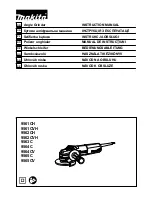
EMERGENCY SAFETY STOP SWITCH
Your boat is equipped with an Emergency Safety Lanyard (cutoff
switch). We recommend that the lanyard be secured to the operator
and the lock plate attached to the emergency cutoff switch prior
to starting the engine and anytime the engine is operating. The
Emergency Safety Lanyard is designed to turn off the engine whenever
the operator moves far enough away from the helm to activate the
switch. The purpose is to stop the engine, propeller, and boat in
the event the operator leaves the helm location, falls overboard, or
is ejected from the boat. If the engine is stopped it will prevent the
boat from becoming a run-away, unmanned boat, which may cause
injury or death to boat occupants who have fallen overboard or been
ejected, or to other nearby people. If the engine stops it will minimize
the subsequent opportunity for propeller contact with the operator or other persons in the water. If the engine and boat stop it will
afford opportunity for the operator or other persons who have fallen overboard to safely re-board the boat.
It is recommended that you use the Emergency Safety Lanyard system as failure to do so can cause death or serious
injury. DO NOT operate the boat if the Emergency Safety Lanyard system does not function properly.
• Attach the Emergency Safety Lanyard to a secure place on your clothing, your arm or your leg while operating.
•
DO NOT
attach the lanyard to clothing that could tear loose.
•
DO NOT
route the lanyard where it could become entangled, preventing it from functioning.
• Avoid accidentally pulling the lanyard during normal operation.
• Loss of engine power means loss of most steering control.
• Without engine power, the boat will decelerate rapidly. This could cause people in the boat to be thrown forward or ejected
overboard if they are not properly seated in the boat.
There are practical limitations to what the Emergency Safety Lanyard can do. It can take several seconds for the engine and
propeller to stop turning. The boat can continue to coast for several hundred feet depending on the boat speed at the time the
switch is activated. While the boat is coasting, it can cause injury to anyone in its path. Accidental loss of power can be hazardous
particularly when docking or in heavy seas, strong current, or high winds.
While at the dock or when the boat is not moving, periodically disconnect/pull the Emergency Safety Lanyard out of the switch
while the engine is running to test for proper operation. The engine should shut off when the lanyard is disconnected/pulled from the
switch. You should not be able to restart the engine until the lanyard is back in place.
PERSONAL FLOTATION DEVICES
Federal law requires that you have at least one wearable Personal Flotation Device
(PFD) of the proper size (Type I, II, III or V), for each person on board or being towed,
and at least one throwable PFD (Type IV) in the boat. PFDs must be Coast Guard
approved, in good and serviceable condition and the appropriate size for the user. To
meet requirements, each lifesaving device must have a current, legible USCG approval
stamp permanently affixed. At the beginning of each season, inspect life jackets (PFDs)
for damage and test for proper flotation. Refer to the life jacket (PFD) manufacturer’s
information.
REMEMBER- The best PFD is the one that is worn – that is, the one that can
save your life.
PFDs are intended to save lives; it is highly recommended that you and
your passengers wear them while in the boat. Learn how to use them and adjust as
necessary for comfort. It is especially important that children and non-swimmers wear
a life jacket (PFD) at all times. Make certain all passengers know where life jackets are
located, how to put on and properly adjust their life jackets (PFDs), and that life jackets
are readily accessible at all times.
Your dealer can help you select appropriate life jackets (PFDs) and throwable
lifesaving devices for your area. Some PFDs are specially made for use while water skiing
or wakeboarding and are not U.S.C.G.-approved. Please check local law with respect to
their use. Some states require children to wear a PFD at all times. There are four types of
wearable PFDs (Type I, II, III or V) and one throwable type of PFD (Type IV) used for
throwing in emergency situations. Examples of these USCG approved PFDs are shown
below:
Type I PFD – Offshore Life jacket:
This PFD is designed for extended survival in rough,
open water. It usually will turn an unconscious person face up and has over 22 pounds of
buoyancy. This is the best PFD to keep you afloat in remote regions where rescue may be
slow in coming.
Type I
Malibu Owners Manual • 2018 • Safety • Page 1-8
Summary of Contents for M235 2018
Page 4: ......
Page 13: ......
Page 14: ...Safety...
Page 48: ...Quick Reference Guide...
Page 69: ......
Page 70: ...Dashes and Video Screens...
Page 109: ......
Page 110: ...How It Works...
Page 134: ...Trailers...
Page 147: ......
Page 148: ...Get Ready...
Page 156: ...Care and Maintenance...
Page 171: ...Malibu Owners Manual 2018 Care and Maintenance Page...
Page 172: ...Malibu Limited Warranty Statement...
Page 182: ......
Page 188: ...Malibu Owners Manual 2018 Warranty Page 8 17...
Page 189: ...Malibu Owners Manual 2018 Troubleshooting Page 8 18...
Page 194: ...Malibu Owners Manual 2018 Service Log Page 8 23 Date Date Date Date Date Date Date Date...
















































